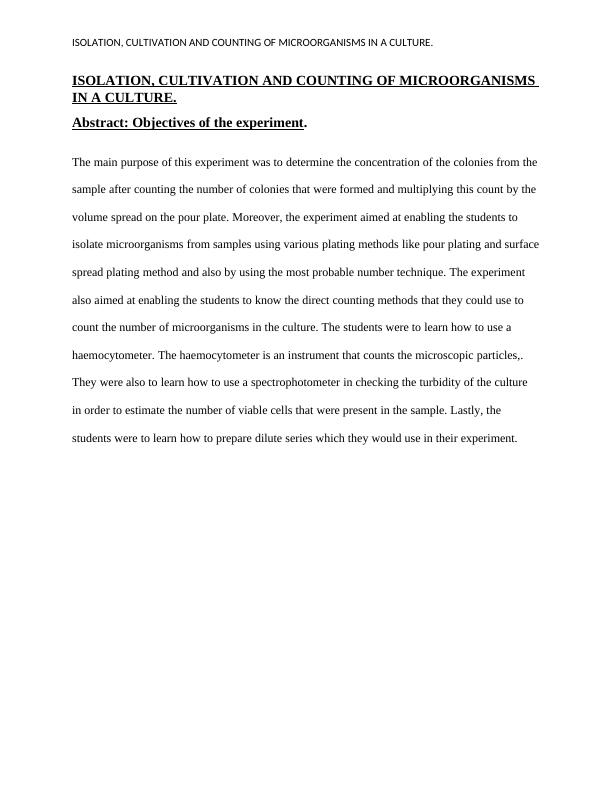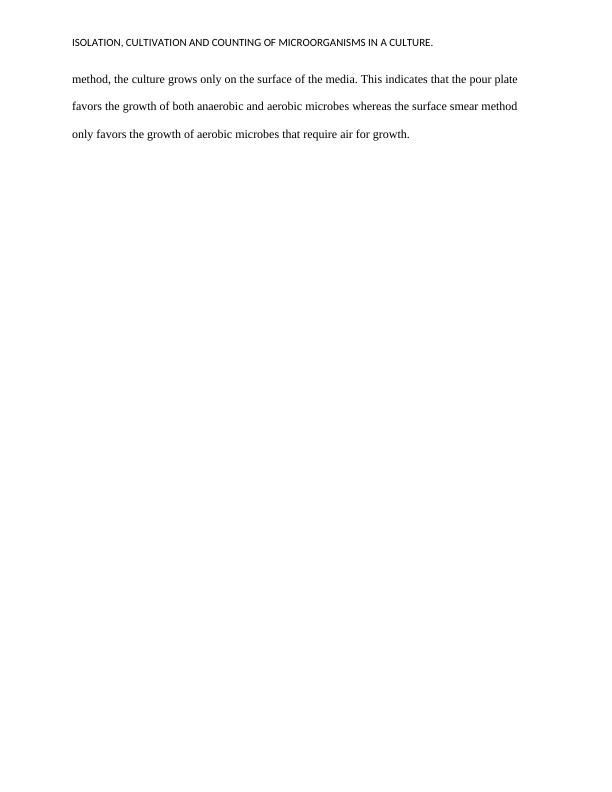Ask a question from expert
Isolation Cultivation and Counting of Microorganisms Assignment PDF
23 Pages3242 Words277 Views
Added on 2021-05-31
Isolation Cultivation and Counting of Microorganisms Assignment PDF
Added on 2021-05-31
BookmarkShareRelated Documents
ISOLATION, CULTIVATION AND COUNTING OF MICROORGANISMS IN A CULTURE.MICROBIAL LABORATORY REPORT NAME OF THE STUDENT INSTITUTION

ISOLATION, CULTIVATION AND COUNTING OF MICROORGANISMS IN A CULTURE.ISOLATION, CULTIVATION AND COUNTING OF MICROORGANISMS IN A CULTURE.Abstract: Objectives of the experiment.The main purpose of this experiment was to determine the concentration of the colonies from thesample after counting the number of colonies that were formed and multiplying this count by the volume spread on the pour plate. Moreover, the experiment aimed at enabling the students to isolate microorganisms from samples using various plating methods like pour plating and surfacespread plating method and also by using the most probable number technique. The experiment also aimed at enabling the students to know the direct counting methods that they could use to count the number of microorganisms in the culture. The students were to learn how to use a haemocytometer. The haemocytometer is an instrument that counts the microscopic particles,. They were also to learn how to use a spectrophotometer in checking the turbidity of the culture in order to estimate the number of viable cells that were present in the sample. Lastly, the students were to learn how to prepare dilute series which they would use in their experiment.

ISOLATION, CULTIVATION AND COUNTING OF MICROORGANISMS IN A CULTURE.Introduction.According to Sagar Anyal (2016), “Spread plate technique is the method of isolation and enumeration of microorganisms in a fixed culture, and distributing it evenly.” The technique separates microbes contained within a small sample volume which is spread over the surface of an agar plate, using a sterile L-shaped glass rod to ensure even distribution of the colonies in order for them to form evenly on the agar surface. Small beads may also be used in place of the L-shaped glass rod to evenly spread the sample over the agar plate to allow for uniform growth of the culture. The plate that is used in spread plating is required when dry and when it is at roomtemperature, in order to ensure that the agar is able to absorb the microbes especially bacteria more rapidly. The spread plate technique is used for viable plate counts, moreover, it is also usedto calculate the cell concentration in the test tube, from which the sample was plated, and finally it is used in the enrichment, selection and screening of experiments. Enrichment is important in the case where the microbe under study exists with another microbe that tends to overgrow I the culture and hence to suppress the growth of the unwanted microbe, the desired microbe is enriched with nutrients that enable it to grow in large colonies. Despite the numerous uses, the method faces some limitations which include: the method favors the rapid growth of aerobes andfacilitates slow growth of micro aerophilic organisms. Also, the colonies in this method cloud and therefore this makes enumeration quite difficult.

ISOLATION, CULTIVATION AND COUNTING OF MICROORGANISMS IN A CULTURE.https://microbiologyinfo.com/wp-content/uploads/2016/10/Spread-Plate-Technique-Principle-Procedure-and-Uses.pdfPour plate method on the other hand is a method that involves the counting of the number of colonies forming the microorganisms that are present in the liquid specimen. In this method, the microbes grow both on the surface and within the medium. According to Tankeshwar (2016), thecolonies that grow within the medium are generally small sized colonies that may be confluent whereas the few microbes that grow in the surface of the medium (agar), are of the same size and

ISOLATION, CULTIVATION AND COUNTING OF MICROORGANISMS IN A CULTURE.appearance as those on the streak plate. The number of microorganisms present in this particular test sample is determined by the formula:Colony Forming Unit (CFU)/ml = CFU × dilution factor × 1/ aliquotThe pair plate method is more efficient in counting the bacteria, however, it gives lower counts because heat sensitive microbes may die when they come into contact with the molten agar.The difference between the pour plate technique and the surface spread method are that for the pour plate method, the microorganisms are in a liquid sample whereas for the surface spread method, the microorganisms are in solid samples. In addition to that, for pour plate method, the cultures grow within the media and on the surface on the media whereas for the surface spread

ISOLATION, CULTIVATION AND COUNTING OF MICROORGANISMS IN A CULTURE.method, the culture grows only on the surface of the media. This indicates that the pour plate favors the growth of both anaerobic and aerobic microbes whereas the surface smear method only favors the growth of aerobic microbes that require air for growth.

End of preview
Want to access all the pages? Upload your documents or become a member.
Related Documents
Food Microbiology - Sample Assignmentlg...
|29
|5686
|364
Methods for Microorganism Enumeration and Factors Affecting Growthlg...
|4
|1279
|72
Microbiology of Food Productslg...
|21
|4661
|253
BHS002: Microbiology & Biochemistrylg...
|18
|3640
|253
Isolation and Characterization of Unknown Bacteria B Using Morphological and Biochemical Testslg...
|6
|2023
|228